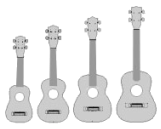History of the ukulele
From beginner to master
|
|
Holding the Ukulele
Holding the Ukulele is like holding a small guitar and should be held at about a forty~five degree angle in front of the body, using a relaxed, comfortable grip. The Ukulele should be held flat against the player's body, while the body of the instrument is supported in place with the forearm of the strumming hand. The forearm is constantly used to hold the back of the instrument against the player's body.




